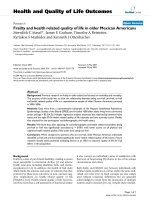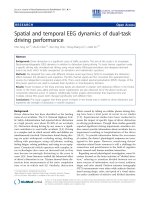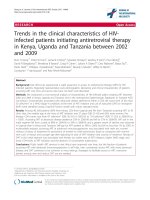Báo cáo hóa học: " Fabrication and ultraviolet photoresponse characteristics of ordered SnOx (x ≈ 0.87, 1.45, 2) nanopore films" potx
Bạn đang xem bản rút gọn của tài liệu. Xem và tải ngay bản đầy đủ của tài liệu tại đây (6.79 MB, 7 trang )
NANO EXPRESS Open Access
Fabrication and ultraviolet photoresponse
characteristics of ordered SnO
x
(x ≈ 0.87, 1.45, 2)
nanopore films
Changli Li
1
, Maojun Zheng
1*
, Xianghu Wang
2
, Lujun Yao
1
,LiMa
3
and Wenzhong Shen
1
Abstract
Based on the porous anodic aluminum oxide templates, ordered SnO
x
nanopore films (approximately 150 nm
thickness) with different x (x ≈ 0.87, 1.45, 2) have been successfully fabricated by direct current magnetron
sputtering and oxidizing annealing. Due to the high specific surface area, this ordered nanopore films exhibit a
great improvement in recovery time compared to thin films for ultraviolet (UV) detection. Especially, the ordered
SnO
x
nanopore films with lower x reveal higher UV light sensitivity and shorter current recovery time, which was
explained by the higher concentration of the oxygen vacancies in this SnO
x
films. This work presents a potential
candidate material for UV light detector.
PACS: 81.15.Cd, 81.40.Ef, 81.70.Jb, 85.60.Gz.
Keywords: highly ordered tin oxide nanopores films, anodized aluminum oxide(aao), ultraviolet(uv) response, oxy-
gen vacancies
Background
Tin oxide is a wide band-gap (3.6 eV) n-type semicon-
ductor and exhibits unique electrical and optical proper-
ties. It h as been used extensively for gas sen sors [1-4],
solar cells [5], optoelectronic devices [6], catalysts [7],
lithium-ion batteries [8], and so forth. In the last few
years, intensive attention has been paid to fabricate a
variety of SnO
2
nanostructured materi als, such as nano-
wires [9], nanobelts [10], nanoribbons [11], nanotubes
[9,12], nanoparticles [13], and nanowhiskers [14]. How-
ever, little attention had been paid to 2D ordered SnO
2
porous nanomaterials as electronic and chemical
devices. 2D ordered porous nanostructures with well-
aligned interconnected pores are of great potential appli-
cations due to several distinctive properties such as high
internal surface areas, high gas sorption and separation
capacity, and increased thermal and mechanical stabili-
ties [15]. Herein, we firstly report the fabrication and
UV photoconductivity switching properties of highly
ordered SnO
x
nanopore films. Figure 1 shows the for-
mation process of the highly ordered SnO
x
nanopore
films . The recovery time of this ordered SnO
x
nanopore
films for UV detection is much shorter than that of
SnO
x
thin films and we also found that the films with
lower x exhibit higher UV sensitivity and faster current
recovery. The results indicate that ordered SnO
x
nano-
pore film with low x could be as potential candidate
material for UV light sensors.
Methods
The AAO templates were prepared through stable high-
field anodization in a H
3
PO
4
-H
2
O-C
2
H
5
OH electrolyte
system [16]. Anodization was carried out i n a H
3
PO
4
-
H
2
O-C
2
H
5
OH electrolyt e system (concentration of
H
3
PO
4
, 0.25 M) at 195 V. The temperatures of the elec-
trolytes were kept at -10°C to 0°C with a powerful low-
constant temperature bath. Sn films were deposited on
AAO substrates by direct current (DC) magnetron sput-
tering using a circular tin target (diameter, 60 mm ; pur-
ity, 99.99%) at room temperature. The base pressure,
deposition pressure, substrate-target distance, sputtering
power, and the Ar flux were 1 × 10
-3
Pa, 0.85 Pa, 6 cm,
30 W, and 10 sccm, respectively. The sputtering time (t)
* Correspondence:
1
Laboratory of Condensed Matter Spectroscopy and Opto-Electronic Physics,
Department of Physics, Shanghai Jiao Tong University, Shanghai, 200240,
People’s Republic of China
Full list of author information is available at the end of the article
Li et al. Nanoscale Research Letters 2011, 6:615
/>© 2011 Li et al; licensee Springer. This is an Open Access article distributed under the terms of the Creative Commons Attribution
License ( which permits unrestricted use, distribution, and reproduction in any medium,
provided the original work is prope rly cited.
was fixed at 3 m in. To obtain the ordered porous SnO
x
films and to perform its ele ctrical measurements under
UV irradiation, three same samples was annealed at
350°C, 450°C, and 550°C in a quartz tube furnace system
for 120 min at a heating rate of 10°C/min, respectively.
The quartz tube was evacuated to about 50 Pa before
heating and the flow rates of Ar and O
2
are both f ixed
at 100 sccm during annealing. Then a 300-nm-thick
gold electrodes was evaporated on the surface of SnO
x
nanopore films through a shadow mask and copper
wires were connected to the electrodes at two contact
pads by conducting silver glue. The spacing between the
electrodes was 1 mm, and the length of the electrodes
was 5 mm. The device structure is depicted in Fig ure
1d. What’ smore,SnO
x
thin films UV device on the
quartz substrate were prepared under the s ame deposi-
tion and post-annealing condition as mentioned above
for the purposes of comparison. Electrical measurements
of all devices were carried out with a Keithley 2400
source-measure unit under ambient conditions. For UV
detection, a xenon lamp was used as the light source
and an excitation filter centered at 254 nm and the bias
voltage was fixed at 1 V. The structural properties were
determined using a D8 DISCOVER X-ray diffractometer
(XRD) with Cu Κa radiation. The growth and surface
morphologies were observed using a field-emission scan-
ning electron microscope (FE-SEM, Philips Sirion 200,
Philips, Holland, Netherlands). The Raman spectra of
the SnO
x
nanostructures were measured using a Jobin
Yvon LabRam HR 800 UV system with a 325 nm He-
Cd laser.
Results and discussions
Surface topography
Figure 2a, b is the top view and cross-sectional FE-SEM
images of a typical AAO template consisting of a
Figure 1 Schematic diagram of the fabrication process of ordered SnO
x
nanopore films. (a) AAO template; (b) top view of the ordered tin
nanopores array on top of AAO; (c) annealing at different temperature; (d) ordered SnO
x
nanopore-film-based UV photodetector.
Li et al. Nanoscale Research Letters 2011, 6:615
/>Page 2 of 7
hexagonal close-packed arrays formed by the two-step
anodization process. The as-grown AAO film has a
large pore diameter of approximately 170 nm and inter-
pore spacing of approximately 350 nm, the parallel
cyli ndrical nanochannels can be clearly observed. Figur e
2c shows the FE-SEM image of Sn nanopore film on an
AAO substrate. The cross-section (he inset of Figure 2c)
reveals clearly that the Sn nanopores are on top of the
AAO substrates. It is noted that the as-deposited Sn
nanopore films consist of small grains and the obtained
Sn films just reproduce the substrate geometry. While
the pore diameter (approximately 150 nm) of Sn
Figure 2 FE-SEM images of the AAO templates, ordered Sn and SnO
x
nanopore films. (a) top view of the alumina template prepared by a
two-step anodization method; (b) cross-section view of the resultant highly ordered nanochannel alumina template; (c) ordered Sn nanopore
film prepared at room temperature with P = 30 W and t = 3 min. (d, f) the top images of the ordered SnO
x
nanopore films prepared at
different annealing temperatures (350°C, 450°C, and 550°C, respectively).
Li et al. Nanoscale Research Letters 2011, 6:615
/>Page 3 of 7
nanopore fil m is smaller than the pore size of the AAO
substrate. Figure 2d, e, f show the surface morphology
of the annealed ordered porous Tin films at different
temperatures (350°C, 450°C, and 550°C). It can be seen
that the grain size of the samples annealed at 350°C was
bigger than that of as-deposited Sn fi lms and the neigh-
boring grains seemed to coalescence together as the
annealing temperature rises. The surface of the film
becomes very smoo th and the pore size of the film
decreases when annealing temperature was increased to
550°C.
Composition evolution after annealing at different
temperature
Figure 3a shows the XRD patterns of the Sn nanopore
filmdepositedatroomtemperatureandSnO
x
films
formed at different annea ling temperatures (35 0°C, 450°
C, and 550°C). It can be seen that the as-prepared Sn
nanopore film consists only of metallic tin, and SnO is
detected with a maximum contribution at 350°C. At the
temperature of 450°C, the diffraction profile can be
indexed by the reflections of SnO phase and Sn
2
O
3
phase. This indicates that the SnO and Sn
2
O
3
are simul-
taneously present at the annealing temperature of 450°
C, and t he intergrowth mechanisms may occur at this
thermal oxidizing temperature. When the annealing
temperature further increases to 550°C, the SnO and
Sn
2
O
3
diffraction peaks disappear, demonstrating that
complete SnO
2
have been formed. This shows that the
oxygen content of Tin oxide films prepared by annealing
oxidizing is very relative to the annealing temperature.
Figure 3b shows the Raman spectr a in the Stocks
frequency range (50 to 1,000 cm
-1
)forSnO
x
films. The
Raman spectrum of the sample annealed at 35 0°C con-
tains strong peaks at approximately 750, 692, 656, 306,
205, and 106 cm
-1
. The strongest peak at 106 and 206
cm
-1
, which is typical of SnO, can be assigned to the B
1g
(113 cm
-1
)andA
1g
(211 cm
-1
) [17]. The bands peaking
at306,692,and750cm
-1
can be correspond to SnO
2
modes E
u
(TO), A
2u
(LO), and E
u
(LO) [18]. In addition to
the fundamental Raman scatterin g peaks of rutile SnO
2
,
the other Raman scattering peaks, which are at about
656 cm
-1
, are also observed. The origin of the 656 cm
-1
mode, which could not be clearly identified, might indi-
cate other SnO
x
stoichiometries. For sample annealed at
450°C, the SnO A
1g
Raman modes disappears and B
1g
Raman modes decreases, indicating the increas e of oxy-
gen in structures. Furthermore, the 656 cm
-1
mode and
SnO B
1g
mode disappear at the annealing temperature
of 550°C, which shows the pure SnO
2
has formed. So
the Raman spectr a also demonstrate th at the oxygen
content increasing with the annealing temperature. The
EDS analysis during FE-SEM observation reveals that
the SnO
x
films (prepared at 350°C, 450°C, and 550°C)
have an approximate atomic ratio of tin to oxygen of
1:0.87, 1: 1.45, and 1:2, respectively. This is consistent
with the results of XRD patterns and Raman spectra.
Photoresponse of the SnO
x
nanopore films under UV
irradiation
The room-temperature current-voltage (I-V) characteris-
tics of the samples all showed a good ohmic behavior
and the conductivity of the SnO
x
films increase with ris-
ing annealing temperature (i.e., increasing film oxygen
Figure 3 XRD patterns Raman spectra of SnO
x
nanopore films. (a) XRD patterns of the as-prepared sample and SnO
x
formed at varying
oxidation temperatures of 350°C, 450°C, and 550°C. The symbol (O) indicates the substrate (Al
2
O
3
) reflections. The phases detected in the film
are indicated as follows: I = Sn; V = SnO; asterisk = Sn
2
O
3
; T = SnO
2
. (b) Evolution of the Raman spectra of SnO
x
nanopore films prepared at
350°C, 450°C, and 550°C.
Li et al. Nanoscale Research Letters 2011, 6:615
/>Page 4 of 7
content) at preparation. To investigate the photore-
sponse of the ordered SnO
x
nanopore films under UV
irradiation, the time-dependent measurements of photo-
response were employed to study the rise and decay
time upon switching UV light on and off. After keepi ng
the sample in the dark for 60 s under t he constant vo l-
tage (1 V), we turn on the UV light to reach the maxi-
mum of the photocurrent and then turn off the light to
observe its recovery characteristics. The reproducibility
of the sample was tested by repeatedly switching UV
light on and off for the same time intervals. At the last
cycle of the measurement, the photocurrent naturally
returns to original value. Figure 4a, c shows the time
evolution of current under UV lamp irradiati on of a
power of I =50μWcm
-2
at RT in air. The time-depen-
dent photoresponse of sample prepared at 350 °C reveals
Figure 4 Time-dependent photoresponse of ordered SnO
x
nanopore films and SnO
x
thin films. (a, c) Time-dependent photorespon se of
ordered SnO
x
nanopore films annealed at 350°C, 450°C, and 550°C, respectively. (d, f) Time-dependent photoresponse of SnO
x
thin films
annealed at 350°C, 450°C, and 550°C, respectively. The measurements were carried out in dry air under 1-V bias voltage and approximately 50-
μWcm
-2
UV illumination.
Li et al. Nanoscale Research Letters 2011, 6:615
/>Page 5 of 7
a current increase steeply upon switching on UV light of
more than ten times of magnitude (Figure 4a). The
response time, defined as the time needed to reach 90%
of the maximum photocurrent, was therefore about 52
s, and rec overy time, defined as the time taken for the
photocurrent to come within 10% of the initial value,
about 270 s. Figure 4b shows the time-dependent photo-
response of the sample prepared at 450°C. The response
time and the recovery time were approximately 70 s and
approximately 1,090 s, the current increase is about two
times of magnitude in this case. For sample prepared at
550°C, a response time of approximately 62 s and a
recovery time of approximately 3,350 s were obtained
and the current increase is no more than one time of
magnitude (Figure 4c). For SnO
x
thin films, the response
time and recovery t ime of the samples prepared at 350°
C, 450°C, and 550°C are approximately 80 and 2,850 s,
approximately 32 and 3,010 s, approximately 100 and >
10,450 s, respectively (Figure 4d, e, f). These results
demonstrated that the ordered SnO
x
nanopore film pre-
pared at lower temperature possess higher UV light sen-
sit ivity and shorter current recovery time. What’smore,
the recovery time of ordered nanopore films is much
shorter than that of thin films and reveal a good reversi-
ble switching characteristics with on/off UV exposure.
Compared to SnO
2
nanowire-based UV detectors, the
response and recovery performance of our UV detector
(prepared at 350°C) was comparable to the SnO
2
nano-
wire array-based UV detector [19] and was still inferior
to single nanowire UV detectors (the response time is
less than 0.1 s) [20]. So t here is still much work to do
to further improve the performance of ordered SnO
x
nanopore-film-based UV detectors in order to meet the
practical application.
The decreased recovery time of the ordered SnO
x
nanopore films compared to the thin films can be
attributed to the increased surface areas. It is known
that the oxygen molecu les are absorbed onto SnO
x
sur-
face by capturing free electrons from the n-type SnO
x
[O
2
(g) + e
-
® O
2
-
(ad)], which decrease the carrier den-
sity in the films and hence the porous films show a
higher resitance. Upon UV illumination, electron-hole
pairs are genera ted. The holes migrate to the surfac e
along the potential slope produced by the band bending
and recombine with the negatively charged adsorbed
oxygen ions [h
+
+O
2
-
® O
2
(g)], resulting in an enhance-
ment of photocurrent. When the illumination is turned
off, the films with higher surface area make O
2
read-
sorbed on the surface easier, which lead to a shorter
recovery time.
For the sample with a lower annealing, temperature
shows a shorter recovery time, which could be attribu-
ted to below two main processes. First, it is known that
oxygen vacancies in SnO
x
act as electron donors and
the number of oxygen vacancies is expected to increase
in lower annealing temperature under certain oxygen
flows and annealing time (confirmed by the results of
XRD pattern and Raman spectra above), higher concen-
tration of the oxygen vacancies will give higher probabil-
ity of the adsorption of oxygen molecules onto the
surface of SnO
x
films, leading to the fast decreasing of
the photocurrent. Second, the increase in the oxygen
vacanciesisexpectedtodecreasethebendingofthe
semiconductor near the surface [21]. Electrons and
holes recombine more easily with less bended band,
inducing a shorter carrier lifetime. So the photocurrent
decay after switching off UV is faster for the sample at
lower annealing temperature.
Conclusions
In conclusion, we firstly report a n effective method for
the fabrication of ordered SnO
x
nanopore films. Anneal-
ing temperature is the key factor to control Sn/O ratio.
Reversible photoconductive switching characteristics of
the films were exhibited by switching UV light on/off,
which is ascribed to the oxygen desorption/reabsorption
on the surface of SnO
x
film. It is noted that the ordered
SnO
x
nanopore films with lower x value possess more
excellent ability to detect weak UV light, which could
be attributed to the higher concentration of the oxygen
vacancies in this SnO
x
films. Especially, this ordered
nanopore films exhibit shorter recovery time compared
to the thin films, which can be attributed to the
increased surface areas. This study presents a new
approach for fabricating UV light sensors based on Tin
oxide films.
Abbreviations
AAO: anodized aluminum oxide; UV: ultraviolet; 2D: two-dimensional; DC:
direct current; XRD: X-ray diffraction; FE-SEM: field-emission scanning
electron microscope; EDS: energy disperse spectroscopy; RT: room
temperature.
Acknowledgements
This work was supported by the National Major Basic Research Project of
2010CB933702, Natural Science Foundation of China (grant No. 11174197,
10874115, 10804071, and 10734020), National 863 Program
2011AA050518863, Shanghai Nanotechnology Research Project
0952nm01900, Research fund for the Doctoral Program of Higher Education
of China. We thank Instrumental Analysis Center of SJTU for SEM analysis.
Author details
1
Laboratory of Condensed Matter Spectroscopy and Opto-Electronic Physics,
Department of Physics, Shanghai Jiao Tong University, Shanghai, 200240,
People’s Republic of China
2
School of Mechanical Engineering, Shanghai
Dianji University, Shanghai 200240, People’s Republic of China
3
School of
Chemistry and Chemical Technology, Shanghai Jiao Tong University
Shanghai, 200240, People’s Republic of China
Authors’ contributions
CLL participated in the design of the study, carried out the total
experiments, performed the statistical analysis, as well as drafted the
manuscript. MJZ participated in the design of the study, provided the
theoretical and experimental guidance, performed the statistic analysis, and
Li et al. Nanoscale Research Letters 2011, 6:615
/>Page 6 of 7
revised the manuscript. XHW helped to operate the Magnetron Sputtering
System. LM participated in the design of experimental section and offered
her the help in experiments. LJY provided helpful suggestion in the analysis
of experimental data. WZS gave his help in the setting up of experimental
apparatus. All authors read and approved the final manuscript.
Competing interests
The authors declare that they have no competing interests.
Received: 3 July 2011 Accepted: 6 December 2011
Published: 6 December 2011
References
1. Katsuki A, Fukui K: H
2
selective gas sensor based on SnO
2
. Sensor Actuator
B: Chem 1998, 52:30-37.
2. Kolmakov A, Zhang Y, Cheng G, Moskovits M: Detection of CO and O
2
using tin oxide nanowire sensors. Adv Mater 2003, 15:997-1000.
3. Law M, Kind H, Messer B, Kim F, Yang PD: Photochemical sensing of NO
2
with SnO
2
nanoribbon nanosensors at room temperature. Angew Chem
Int Ed 2002, 41:2405-2408.
4. Comini E, Faglia G, Sberveglieri G: UV light activation of tin oxide thin
films for NO
2
sensing at low temperatures. Sensor Actuator B: Chem 2001,
78:73-77.
5. Ferrere S, Zaban A, Gregg BA: Dye sensitization of nanocrystalline tin
oxide by perylene derivatives. J Phys Chem B 1997, 101:4490-4493.
6. Aoki A, Sasakura H: Tin oxide thin film transistors. Jpn J Appl Phys 1970,
9:582.
7. Bond GC, Molloy LR, Fuller MJ: Oxidation of carbon monoxide over
palladium-tin(IV) oxide catalysts: an example of spillover catalysis. J
Chem Soc Chem Comm 1975, 19:796-797.
8. Park MS, Wang GX, Kang YM, Wexler D, Dou SX, Liu HK: Preparation and
electrochemical properties of SnO
2
nanowires for application in lithium-
ion batteries. Angew Chem 2007, 119:764-767.
9. Dai ZR, Gole JL, Stout JD, Wang ZL: Tin oxide nanowires, nanoribbons,
and nanotubes. J Phys Chem B 2002, 106:1274-1279.
10. Duan JH, Yang SG, Liu HW, Gong JF, Huang HB, Zhao XN, Zhang R, Du YW:
Single crystal SnO
2
zigzag nanobelts. J Am Chem Soc 2005,
127:6180-6181.
11. Hu JQ, Ma XL, Shang NG, Xie ZY, Wong NB, Lee CS, Lee ST: Large-scale
rapid oxidation synthesis of SnO
2
nanoribbons. J Phys Chem B 2002,
106:3823-3826.
12. Wang Y, Zeng HC, Lee JY: Highly reversible lithium storage in porous
SnO
2
nanotubes with coaxially grown carbon nanotube overlayers. Adv
Mater 2006, 18:645-649.
13. Leite ER, Weber IT, Longo E, Varela JA: A new method to control particle
size and particle size distribution of SnO
2
nanoparticles for gas sensor
applications. Adv Mater 2000, 12:965-968.
14. Ying Z, Wan Q, Song ZT, Feng SL: SnO
2
nanowhiskers and their ethanol
sensing characteristics. Nanotechnology 2004, 15:1682-1684.
15. Sun FQ, Cai WP, Li Y, Jia LC, Lu F: Direct growth of mono- and multilayer
nanostructured porous films on curved surfaces and their application as
gas sensors. Adv Mater 2005, 17:2872-2877.
16. Li YB, Zheng MJ, Ma L, Shen WZ: Fabrication of highly ordered
nanoporous alumina films by stable high-field anodization.
Nanotechnology 2006, 17:5101-5105.
17. Geurts J, Rau S, Richter W, Schmitte FJ: SnO films and their oxidation to
SnO
2
: Raman scattering, IR reflectivity and X-ray diffraction studies. Thin
Solid Films 1984, 121:217-225.
18. Diéguez A, Romano-Rodríguez A, Vilà A, Morante JR: The complete Raman
spectrum of nanometric SnO
2
particles. J Appl Phys 2001, 90:1550-1557.
19. Wu JM, Kuo CH: Ultraviolet photodetectors made from SnO
2
nanowires.
Thin Solid Films 2009, 517:3870-3873.
20. Liu ZQ, Zhang DH, Han S, Li C, Tang T, Jin W, Liu XL, Lei B, Zhou CW: Laser
ablation synthesis and electron transport studies of tin oxide nanowires.
Adv Mater 2003, 15:1754-1757.
21. Vlachos DS, Papadopoulos CA, Avaritsiotis JN: Dependence of sensitivity of
SnO
x
thin-film gas sensors on vacancy defects. J Appl Phys 1996,
80:6050-6054.
doi:10.1186/1556-276X-6-615
Cite this article as: Li et al.: Fabrication and ultraviolet photoresponse
characteristics of ordered SnO
x
(x ≈ 0.87, 1.45, 2) nanopore films.
Nanoscale Research Letters 2011 6:615.
Submit your manuscript to a
journal and benefi t from:
7 Convenient online submission
7 Rigorous peer review
7 Immediate publication on acceptance
7 Open access: articles freely available online
7 High visibility within the fi eld
7 Retaining the copyright to your article
Submit your next manuscript at 7 springeropen.com
Li et al. Nanoscale Research Letters 2011, 6:615
/>Page 7 of 7









